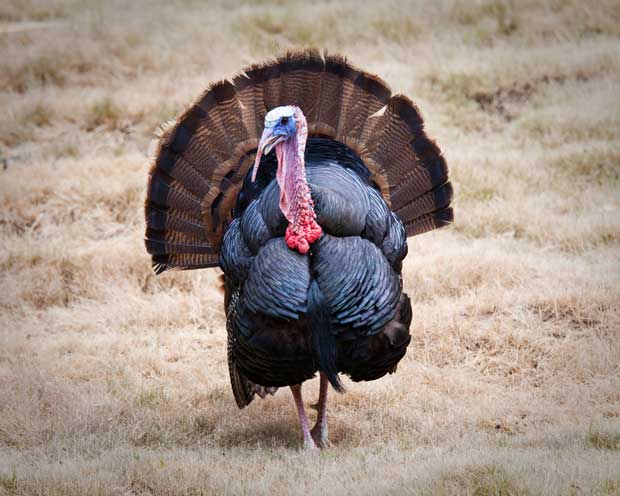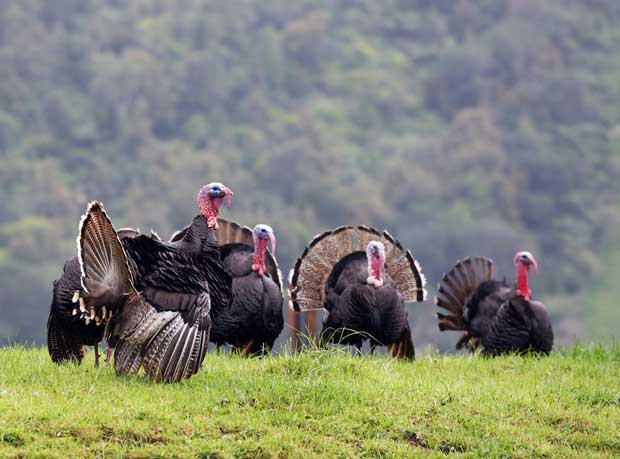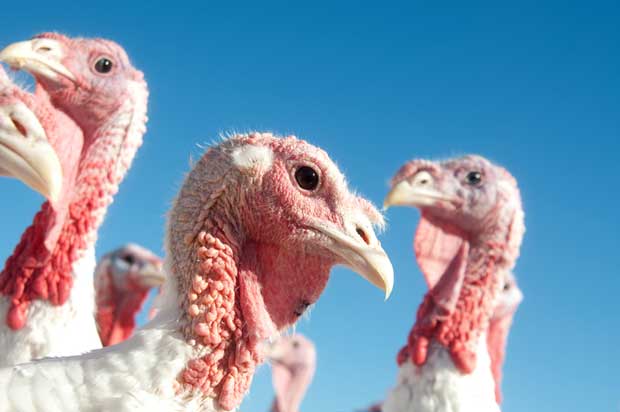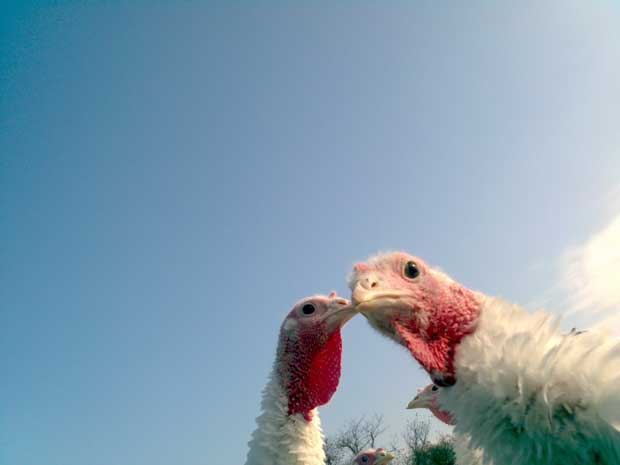Why you should consider raising turkeys

Turkeys are beautiful birds, work hard to keep your farm pest-free and make a great roast.
Words: Nadene Hall
Turkeys have a bit of reputation as being difficult to breed, constantly succumbing to disease, and a real bugger to cook, but none of that is true for rare breed enthusiast Andrea Gauland. The former American – now a proud Kiwi – says she thoroughly enjoys owning turkeys and has never had a problem raising or cooking them.
“I don’t find it difficult at all. They are really hard to get hold of because there aren’t many people who breed them – that’s such a shame – and I know people say don’t keep chickens near them because of blackhead, but I don’t want to pen anything up.
“The few deaths we’ve had, it has been mothers losing poults, or over-enthusiastic males stomping a female (they go very weird at mating time). Overall, they’re pretty hardy birds as far as lice and mites go, we haven’t found any lice on our turkeys. They don’t seem to get leg mites at all, at least, not in our experience. They’re a pretty easy-care bird.”
While there are more colour variations in their native homeland of the woodlands of the USA, NZ has bronze, white, buff and royal palm turkeys, and the broad-breasted white, the turkey equivalent of the Cobb meat chicken.
Andrea has bronze and white turkeys, with the whites being her favourites.
“They have real personality, they’re really neat to watch, being white with a bright red head and blueish sort of face, they are very striking.”
Ashburton turkey enthusiast Debbie Phipps bought her first pair of turkeys after seeing some on a local farm and was delighted by their winning personalities.
“We started out with buffs, and a beautiful old friendly bird, he was called Bert. He was very, very protective, sometimes my dad would come to visit and he didn’t like my dad, so he would protect me like I was one of his girls!”
BREEDING
Turkey hens start laying in spring in their second year, laying clutches of eggs, then going broody and sitting on them, but fertile eggs can go under broody bantams or larger hens too, with hatching taking place 28 days later.
If you’re more interested in buying day old poults it’s best to either talk to a breeder and arrange things ahead of time, or if you want meat birds, get day old poults (of the broad-breasted white only) from a commercial company.
Turkey poults should be penned up with their mother (or under a heat lamp if being hand-raised) for their own protection says Debbie.
“They’re really good mums but they’re quite thick! You need a good, warm house otherwise they take their babies out into long grass and they get wet and die. A house and a run is good, our houses were maybe 2m x 4m, and then a run off the front (6m), with deer fencing.”

A good run will also offer protection from predators like hawks, dogs, cats, rats and hedgehogs. Andrea keeps her poults in a run with their mother (or adopted mother) until they are feathered up, usually at around the 6-8 week mark.
Once released to roam the farm, they are fed on grains, cooked barley (in winter), vege scraps and get to graze free-range on the Gauland’s 10 acre block.
“We like them to be free to forage, they get fed twice a day on mixed grains, but then they’re free to eat grass and insects. They’re excellent grazers, they move like a mob of sheep, but they hunt down bugs too, they’re actually rather loud when they find some. They scratch, but not like chickens do, not as aggressively.”
Keeping control of predators is important, especially rats and hedgehogs. Andrea and her husband Michael have discovered they have a rampant and quite large hedgehog population that isn’t afraid to go for a live poult.
Another advantage of penning up turkey poults is to give them an idea of where their home range is, as being woodland birds they do like to wander over a wide area. Despite their weight and any obvious signs of aerodynamics, most adult turkeys can fly except for the heavy toms (male turkeys) so you may choose to clip the primary wing feathers (on one wing only) if you want to graze them in a pasture of your choice.
“They just go where they want to really, it can be a hard time keeping turkeys at home,” says Andrea. “Whenever we bring a new bird home we keep them penned up for a couple of weeks, then they don’t tend to go more than 40-50 metres from their house, which they sleep on, not in. They’re not really co-operative!
“They’ve broken a bunch of branches, the lower limbs on the fruit trees and alder trees that we planted, especially the (heavier) boys.”
The Phipps family also found their turkeys took liberties, especially the ones that were hand-raised.

“They are very social and they get very attached to you,” says Debbie. “The problem is one day my husband got home to find them all lined up along the verandah because it was raining. They do pooh a lot, so you really do need a turkey house.
“Ours had beautiful houses, but they are just so thick. One day we woke up to find it had snowed overnight and they were all sitting on top of their houses, covered in snow, because they wanted to perch at the highest point!”
Debbie has bred some of the more beautiful but smaller turkey breeds available in New Zealand, the buff and what she calls “pied”, close to the colouring of a royal palm, but not quite.
However, the Gauland family prefers the traditional domestic turkey breeds (bronze, white) for meat. These breeds grow more slowly than the purpose-bred, fast-growing meat turkey, the broad breasted white. The difference in growth is amazing: a white or bronze turkey is ready for eating at around the 18 month mark and dresses out at 10-12kg (for toms) and 5-6 kilos (for hens). The very meaty broad breasted whites need to be processed at about three months of age but dress out at the same weights.
“When the (broad breasted white) boys are 4-6 months old they can hardly walk,” says Andrea. “Their breast is so big and they’re so heavy. We’ve bought day old poults and that was the longest we could keep them.”
The Gauland family now prefer the slower-growing turkeys for their taste, but then their family is a little unusual in that regard says Andrea.
“Ours take longer to grow because they are free-range, if you penned them and fed them on grower mash they’d plump up a lot faster. You’re exchanging size for taste, at least according to my palate, but we’re slow food proponents.
“It tastes like chicken! We eat roosters when they’re 8-10 months old and it’s like that, it’s a stronger-tasting meat, mostly to do with age and they are running around more than a caged bird. It’s tougher so we just prepare the meat differently. I like turkey meat, that’s really what it comes down to.”
Turkeys are killed and processed in exactly the same manner as chickens, except the Gaulands don’t have anything big enough to scald them in so they just dry pluck them. It’s a bit more work says Andrea, but you get a clean carcase, especially from white feathered birds.
All this means the Christmas turkey is in the freezer well ahead of time. Eggs hatched in November-February are left to grow over 15-18 months, and are then processed in the autumn so they don’t have to be fed through a second winter.
The Gaulands process birds for roasting and stewing, cut some up into pieces and anything left over is made into turkey mince, a family favourite.
“It’s a really nice mince, we mince the leg meat. Maybe it’s sort of an American thing, but we make sausages from chicken and turkey meat.”
SLOW ROASTERS
Watch any American TV comedy show and it would seem that cooking the Thanksgiving turkey is a really big deal and difficult to get right, but that’s a really strange myth in Andrea’s experience.
“I slow roast them, put a bit of water in the bottom of a roasting dish, slow roast at 120°C for four hours and the meat literally falls off the bone.
“I don’t know where that (myth) comes from, or maybe I had a good teacher. I guess it takes longer for certain parts of the turkey, I’ve never had a dry turkey. I do what my mother always did, put a bit of butter and sage leaves under the skin on the breast, put some foil over the breast so it doesn’t cook as fast, then 30 minutes from the end I take the foil off so it goes brown.”
TURKEYS FOR EATING
When processing a bird, tuck the legs of the turkey in close so the drumsticks stay moister during cooking. The more quickly you can freeze (or preferably snap freeze) the carcase, the more moisture you keep in the meat.
Turkey eggs aren’t often available for eating (most are used for hatching) as turkeys don’t lay prolifically like hens (an average of 4.5 eggs per week for 24 weeks in commercial flocks). Turkey eggs weigh 80-90g, about the size of a double yolker chicken egg, and are excellent for scrambling, or if a fluffy texture is required in baking. They taste very similar to hen’s egg.
When thawing a frozen turkey, allow:
– 8-12 hours per kilo if in the fridge (4°C)
– 3-4 hours per kilo in a cool room (17.5°C)
– 2 hours per kilo at room temperature (20°C)
Once thawed and in the fridge, a turkey roast will keep for two days. When roasting, for a bird under 4kg allow 20 minutes per kg + 70 minutes. If the bird is over 4kg allow 20 minutes per kg + 90 minutes. Leave the turkey to stand for at least 15-20 minutes before carving.
TALKING TURKEY
Poult – baby turkey, from day old
Tom – male turkey
Hen – female turkey
Snood – the flap of skin that hangs over the turkey’s beak, turns bright red when the turkey is upset or during courtship.
Dewlap – the flap of skin under the turkey’s chin, turns bright red when the turkey is upset or during courtship.
Caruncles – large, bulbous growths on the neck that tend to get bigger in spring/mating season.
FEEDING TURKEYS
Turkeys require higher levels of protein than chickens, and should be fed a specialist diet. Turkey breeder Debbie Phipps says it’s vital to feed a proper turkey starter feed from day one if you can get it – not chick starter – as it will contain the right levels of protein, and additives.
A meat bird crumble will contains around 24.5% protein and and that level is suitable for feeding to turkeys from one day old, but meat bird crumbles don’t contain the additives that help to prevent poults getting blackhead disease.
If you’re worried poults aren’t getting enough protein you can add tinned cat food (jellymeat), crumbled egg yolk or cooked mince to their diet.
WHERE TO FIND TURKEY FEED
Before you order any poults, ask your rural farm supplier to order in meat bird or turkey crumbles as they may not have bags in stock, but both can be ordered in 25kg bags.
Most commercial turkey hatcheries and rearing facilities are based in the South Island, so Christchurch-based readers may have the best opportunity for getting the specific turkey crumble available from Inghams.
TURKEY TIPS

1. If you are a beginner, Andrea recommends buying feathered poults or adult birds.
2. Turkeys are excellent at cleaning up insect infestations, especially insect pests like grass grub.
3. Turkey hens don’t tend to start laying until their second year.
4. A bantam can sit on three turkey eggs, a larger breed of hen up to six, while an adult turkey hen can sit on up to 28 eggs at a time.
5. Young turkeys should be raised separately to adults in a flock to avoid “hen-pecking” and so they can gain immunity to disease.
6. Newly-hatched poults need either the warmth of their mother (or adopted mother), or a heat lamp, and are very susceptible to the cold until fully feathered at 6-8 weeks. Only allow them to go outside when it is fine/warm, and make sure it is into a well-fenced area so they can’t wander away says Andrea. “Turkey mothers don’t count very high, they won’t wait in the cold, and poults chill really easily.”
7. The two most common times for deaths are in weeks 1-2 (cold, predators), and then when transitioning onto pasture (disease, predators).
8. Make sure feed dishes are wide, low-sided trays so poults can easily find feed, and only use shallow water trays, even if it means cleaning them morning and night. “My biggest problem was I lost some drowning in water dishes,” says Debbie. “It was absolutely devastating, the dish has to be big enough for them to drink from but not so deep that they drown.”
9. When feeding young poults, whistle every time you put feed out. This mimics what their mother would do, and trains them to come to you (useful if you wish to lock them up overnight).
10. Turkeys like to perch, and if you can convince them to perch where you want them to (not often possible say Andrea and Debbie), they like perches to be 30-45cm off the ground and at least 50cm apart, with 30-40cm of perch space per bird. Keep perches at the same level to avoid fighting over higher perches.
11. If feeding multiple turkeys, make sure there is enough space for all birds to get feed, at least 10cm of feeder each, especially if feed is not ad lib.
12. Toms are loud when excited, but turkeys tend to be pretty passive says Andrea. “One year we had 30 or so, there was not a lot of bloodshed, they didn’t fight, even during breeding.”
13. You can herd turkeys if they won’t come to your call/whistle. Use a long stick with a plastic bag or flag on the end, or tap a plastic bottle on the ground.
14. Turkeys are great flock guardians. While the Gauland’s turkeys tolerate their free-range poultry flock, the pigs and other livestock, they will puff up and attack if they or their fellow livestock are threatened by diving plovers or hawks.
BLACKHEAD DISEASE
This is the dreaded disease in a turkey flock, caused by a protozoa parasite (Histomonis melagridis) and usually deadly to poults aged from three to 18 weeks of age.
Earthworms, snails and cecal worms carry the protozoa parasite. Chickens and other poultry can be infested but show no clinical signs and pass it on to the more susceptible turkeys, which is why it’s recommended that chickens and turkeys be farmed separately.
“We haven’t had any trouble with blackhead,” says Andrea. “We keep them (chickens and turkeys) together, maybe it’s more luck for us, I don’t know.”
Symptoms: birds will be depressed, huddled, have foamy pale yellow diarrhoea, will stop eating and be very thirsty, have droopy wings, and the wattle and comb go dark blue-black (hence “blackhead”), can cause stunted growth in older birds, death within a few days in young birds.
Treatment: additives in turkey starter feed help poults, but preventative methods are best. This involves keeping turkeys and other poultry separate, running them on separate pasture, and not putting turkeys on pasture for at least two years after chickens have been removed.
WHERE TO FIND FERTILE TURKEY BREEDERS
For a list of breeders nationwide: Rare Breeds Conservation Society
Love this story? Subscribe now!
 This article first appeared in NZ Lifestyle Block Magazine.
This article first appeared in NZ Lifestyle Block Magazine.

